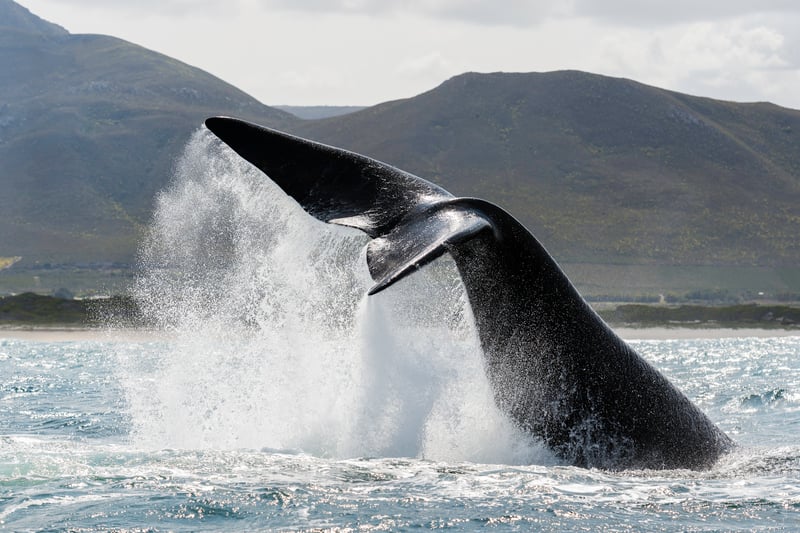
With only hundreds of these animals left, this is truly a horrifying scene.
Once numerous off the East Coast, the North Atlantic right whale population has less than 360 individuals. So far, 2024 has been a devastating year for the endangered species, who are extremely susceptible to entanglement in fishing gear and collisions with ships.
About 50 miles south of Rhode Island’s Block Island, the National Oceanic and Atmospheric Administration (NOAA) spotted an adult male whale with rope coming out of both sides of his mouth while conducting an aerial survey. While the whale is far from shore, making rescue efforts difficult, NOAA Fisheries and their partners are currently monitoring the whale in an attempt to respond to the entanglement.
At this time, the whale can swim freely because the rope is not wrapped around his entire body, and the entanglement is categorized as a sublethal injury.
Migrating every year from calving grounds in Florida and Georgia to feeding grounds off New England and Canada, climate change and increasingly warmer waters have made these animals more susceptible to entanglements and collisions as their food sources move. The climate change-induced warming in the Gulf of Maine is acutely endangering the right whale, according to a 2023 study.
The leading cause of death for this critically endangered species is vessel strikes and entanglement. Environmental groups fear the species could be heading for extinction as several right whales have died off in Georgia and Massachusetts in recent months. Entanglements and vessel strikes are unfortunately becoming more common as waters warm and whales change their migration patterns.
A one-year-old male humpback whale was found dead last week on Long Beach Island in New Jersey with injuries consistent with a vessel strike: blunt force trauma including bruising and a hematoma in the head, multiple skull and neck vertebrae fractures, and internal organ damage. The whale also had entanglement scars, though experts believe it was unrelated to the whale’s death.
An entangled gray whale was also spotted off the Peninsula Coast last week, a gillnet and buoys wrapped around the tail, with NOAA attempting to free the whale for weeks. Gillnets, used in the commercial fishing industry, have a fine mesh that is difficult to untangle. The juvenile whale is currently tagged with a tracking device in order to keep track of them as they swim further north to their feeding grounds in Alaska, but rescuers noted the whale was beginning to thin out, meaning they’re not able to forage.
In January 2024, a juvenile female right whale (No. 5120) washed up in Martha’s Vineyard with clear injuries from rope entanglements. NOAA conducted an investigation, concluding the whale died from chronic entanglement of commercial fishing gear linked to the Maine lobster industry.
The rope was observed being wrapped around the tail of 5120 for more than half of her 3-year life, digging into her flesh to the point where tissue was growing over the rope long before she perished. Scientists concluded that she spent the entire time she was entangled in chronic pain, as the rope cut deeper into her tissue as her body expanded—due to having to use her tail constantly to swim.
Just weeks later, another juvenile female right whale was found floating dead offshore of Savannah, Georgia, with her necropsy concluding she died from a vessel strike with injuries including blunt force trauma.
Two fin whales have also died on the Pacific Coast since mid-December 2023, and a federal judge in San Francisco ruled in March 2023 that US wildlife officials are violating their legal duty by failing to protect endangered Pacific humpback whales from being killed in government-approved underwater gear off the coast of California.
NOAA confirmed the deaths of 28 entangled whales off the coasts of Oregon, Washington, and California in 2022, plus two from the coasts of Mexico and Alaska entangled in West Coast fishing gear. Of the 30 whales, 18 were endangered humpback whales, 10 gray whales, one killer whale, and one fin whale. Three humpback whales were entangled in Dungeness crab equipment in California during the 2022 season, forcing an early closure.
While animal protection and environmental groups have been raising alarms about the effects of the commercial fishing industry for years, a 2022 US budget package was passed that included a six-year pause on new federal whale regulations.
In 2015, World Animal Protection launched the Global Ghost Gear Initiative (GGGI) in order to achieve safer, cleaner oceans by driving solutions that tackle the problem of abandoned, lost, and discarded fishing gear globally. Now a separate organization, the Global Ghost Gear Initiative (GGGI) works with over 150 seafood companies, retailers, non-profits, governments, academic institutions, intergovernmental organizations, and more.
Around the globe, abandoned, discarded, or lost fishing gear (also known as ghost gear) is killing countless sea animals and trashing our oceans. World Animal Protection estimates that each year 640,000 tons of fishing gear are lost and pollute the world’s oceans, killing more than 300,000 whales and dolphins annually.
According to Britannica, more than 40 percent of all animals caught by commercial fisheries are non-targeted species (by-catch) killing more than 650,000 marine mammals worldwide annually.
While many assume their consumption of fish only affects the species they’re eating, records of marine species dying in commercial fishing nets show this is far from the truth. Whether a slow death from rope around their bodies or drowning from becoming fully entangled and unable to reach the surface to breathe, it’s clear that our overconsumption of marine species is killing our oceans.
If you think farming fish—aquaculture—is the answer, think again. Many fish raised in underwater factory farms suffer from severe depression, often floating lifelessly in their filthy, crowded tanks.
With so many amazing plant-based seafood options, there’s no reason we cannot greatly reduce or eliminate our fish consumption to protect endangered marine life. Join our Plant-Powered Changemakers community today to find compassionate sea-inspired plant-based recipes.